The Influence of the Morphological Characteristics of Mining-Induced Ground Fissures on the Spatiotemporal Distribution of Soil Moisture
Abstract
:1. Introduction
2. Materials and Methods
2.1. HYDRUS Model Creation
- (1)
- Numerical simulation parameter measurement.
- (2)
- Selection of water flow model and water characteristic curve.
- : Soil saturated hydraulic conductivity.
- : Soil residual volume moisture content.
- : Relative saturation of soil.
- : Soil saturation volume moisture content.
- a, n: Empirical functions determined by experiments.
- m: 1-1/n.
- h: Negative pressure head (cm).
- (3)
- Model time and output settings.
- (4)
- Initial conditions and hydraulic parameter settings of soil.
- (5)
- The addition of observation points and the setting of boundary conditions.
2.2. Accuracy Evaluation of HYDRUS Simulated Data and Measured Data
- RMSE: Root-mean-square error.
- RE: Relative error.
- S: The moisture content value simulated by HYDRUS.
- O: The measured moisture content value.
- n: The number of samples participating in the evaluation.
2.3. Simulating the Influence of Different Fissure Morphologies on Soil Moisture
2.3.1. Simulating Planar Fissures of Different Widths
- : The maximum moisture content of fissures with different shapes at the same location on the first day.
- : The minimum moisture content of fissures with different shapes at the same location on the first day.
- : The maximum moisture content of fissures with different shapes at the same location on the nth day.
- : The minimum moisture content of fissures with different shapes at the same location on the nth day.
- : The maximum moisture content of fissures with different shapes at the same location.
- n: Number of days participating in the operation.
2.3.2. Planar Fissures with Different Depths
2.3.3. Stepped Fissures with Different Widths
3. Results and Analysis
3.1. The Effect of Planar Fissures with Different Widths on Soil Moisture Transport
3.2. The Effect of Stepped Fissures with Different Widths on Soil Moisture Transport
3.3. The Influence of Planar Fissures at Different Depths on Soil Moisture Transport
3.4. Impact of Stepped Fissures at Different Depths on Soil Moisture Transport
3.5. Impact Differences of Different Ground Fissure Morphologies on Soil Moisture
- : The soil moisture content of stepped fissures.
- : The soil moisture content of planar fissures.
4. Discussion
4.1. Technical Advantages of Studying the Effect of Fissures on Soil Moisture Based on HYDRUS
4.2. Impact of Mining-Induced Fissures on Soil Moisture Transport
4.3. Impact of Fissure Morphological Factors on Soil Moisture Transport
5. Conclusions
Author Contributions
Funding
Data Availability Statement
Conflicts of Interest
References
- Liu, H.; Deng, K.; Zhu, X.; Jiang, C. Effects of mining speed on the developmental features of mining-induced ground fissures. Bull. Eng. Geol. Environ. 2019, 78, 6297–6309. [Google Scholar] [CrossRef]
- Bi, Y.; Xie, L.; Wang, J.; Zhang, Y.; Wang, K. Impact of host plants, slope position and subsidence on arbuscular mycorrhizal fungal communities in the coal mining area of north-central China. J. Arid Environ. 2019, 163, 68–76. [Google Scholar] [CrossRef]
- Mi, J.; Yang, Y.; Hou, H.; Zhang, S.; Ding, Z.; Hua, Y. Impacts of ground fissures on soil properties in an underground mining area on the Loess Plateau, China. Land 2022, 11, 162. [Google Scholar] [CrossRef]
- Wu, L.; Tian, J.; Tang, Y.; Zhu, Z. Effects of collapse-fissure on soil moisture in arid and semi-arid mining area. South North Water Divers. Water Technol. 2019, 17, 115–120. [Google Scholar]
- Li, X.; Wang, S.; Liu, T.; Ma, F. Engineering geology, ground surface movement and fissures induced by underground mining in the jinchuan nickel mine. Eng. Geol. 2004, 76, 93–107. [Google Scholar] [CrossRef]
- Chen, J.; Zhu, Z.; Wu, L. Physical model test on moisture diffusion in discontinuous homogeneous soil with collapse-fissure. Chin. J. Geol. Hazards Prev. 2018, 29, 66–72. [Google Scholar]
- Du, G.; Chen, X.; Qie, C.; Yang, D. Impacts of Cracks on Soil Moisture and Surface Shear Strength in Semi-Arid Mining Area. J. Ecol. Rural. Environ. 2016, 32, 1673–4831. [Google Scholar]
- Xu, C.; Shouchen, M.; Zhang, H.; Wang, R.; Guan, Z. Effect of cracks on soil characteristics and crop growth in subsided coal mining areas. Chin. J. Eco-Agric. 2015, 23, 597–604. [Google Scholar]
- Wang, Q.; Dong, S.; Wang, H.; Yang, J.; Wang, X.; Zhao, C.; Zhang, X. Influence of mining subsidence on soil water movement law and its regulation in blown-sand area of Western China. J. Coal Sci. 2021, 46, 1532–1540. [Google Scholar] [CrossRef]
- Zhang, J.; Bi, Y.; Song, Z.; Xiao, L.; Christie, P. Arbuscular mycorrhizal fungi alter root and foliar responses to fissure-induced root damage stress. Ecol. Indic. 2021, 127, 107800. [Google Scholar] [CrossRef]
- Bi, Y.; Wu, Y.; Zhang, J.; Pang, S. Simulation of soil water and salt movement in mining ground fissure zone based on HYDRUS. J. Coal Sci. 2020, 45, 360–367. [Google Scholar]
- Van Genuchten, M.T. A closed-form equation for predicting the hydraulic conductivity of unsaturated soils. Soil Sci. Soc. Am. J. 1980, 44, 892–898. [Google Scholar] [CrossRef]
- Wang, W.; Lu, Y. Analysis of the mean absolute error (MAE) and the root mean square error (RMSE) in assessing rounding model. In IOP Conference Series: Materials Science and Engineering, Proceedings of the 2017 the 5th International Conference on Mechanical Engineering, Materials Science and Civil Engineering, Kuala Lumpur, Malaysia, 15–16 December 2017; AIP Publishing: Melville, NY, USA, 2018; p. 012049. [Google Scholar]
- Šimůnek, J.; Van Genuchten, M.T.; Šejna, M. Recent developments and applications of the HYDRUS computer software packages. Vadose Zone J. 2016, 15, 1–25. [Google Scholar] [CrossRef]
- Pucher, B.; Langergraber, G. Simulating vertical flow wetlands using filter media with different grain sizes with the HYDRUS Wetland Module. J. Hydrol. Hydromech. 2018, 66, 227–231. [Google Scholar] [CrossRef]
- Šimůnek, J.; Van Genuchten, M.T.; Kodešová, R. Thematic issue on HYDRUS software applications to subsurface fluid flow and contaminant transport. J. Hydrol. Hydromech. 2018, 66, 129–132. [Google Scholar] [CrossRef]
- Wang, X. Vapor Flow Resistance of Dry Soil Layer to Soil Water Evaporation in Arid Environment: An Overview. Water 2015, 7, 4552–4574. [Google Scholar] [CrossRef]
- Wang, C.; Fu, B.; Zhang, L.; Xu, Z. Soil moisture–plant interactions: An ecohydrological review. J. Soils Sediments 2019, 19, 1–9. [Google Scholar] [CrossRef]
- Huang, C. Pedology; China Agriculture Press: Beijing, China, 2000. [Google Scholar]
- Huang, X. Study on the Effect of the Wind and the Light to the Soil Moisture Evaporation and Moist-Locking Measures; Lanzhou University of Technology: Lanzhou, China, 2011. [Google Scholar]
- Li, X.; Wang, F.; Hu, L.; Mu, X. Impact of wind-speed and straw-mulching on soil water evaporation. Agric. Res. Arid. Areas 2011, 29, 186–190. [Google Scholar]
- McVicar, T.R.; Roderick, M.L.; Donohue, R.J.; Li, L.T.; Van Niel, T.G.; Thomas, A.; Grieser, J.; Jhajharia, D.; Himri, Y.; Mahowald, N.M. Global review and synthesis of trends in observed terrestrial near-surface wind speeds: Implications for evaporation. J. Hydrol. 2012, 416, 182–205. [Google Scholar] [CrossRef]
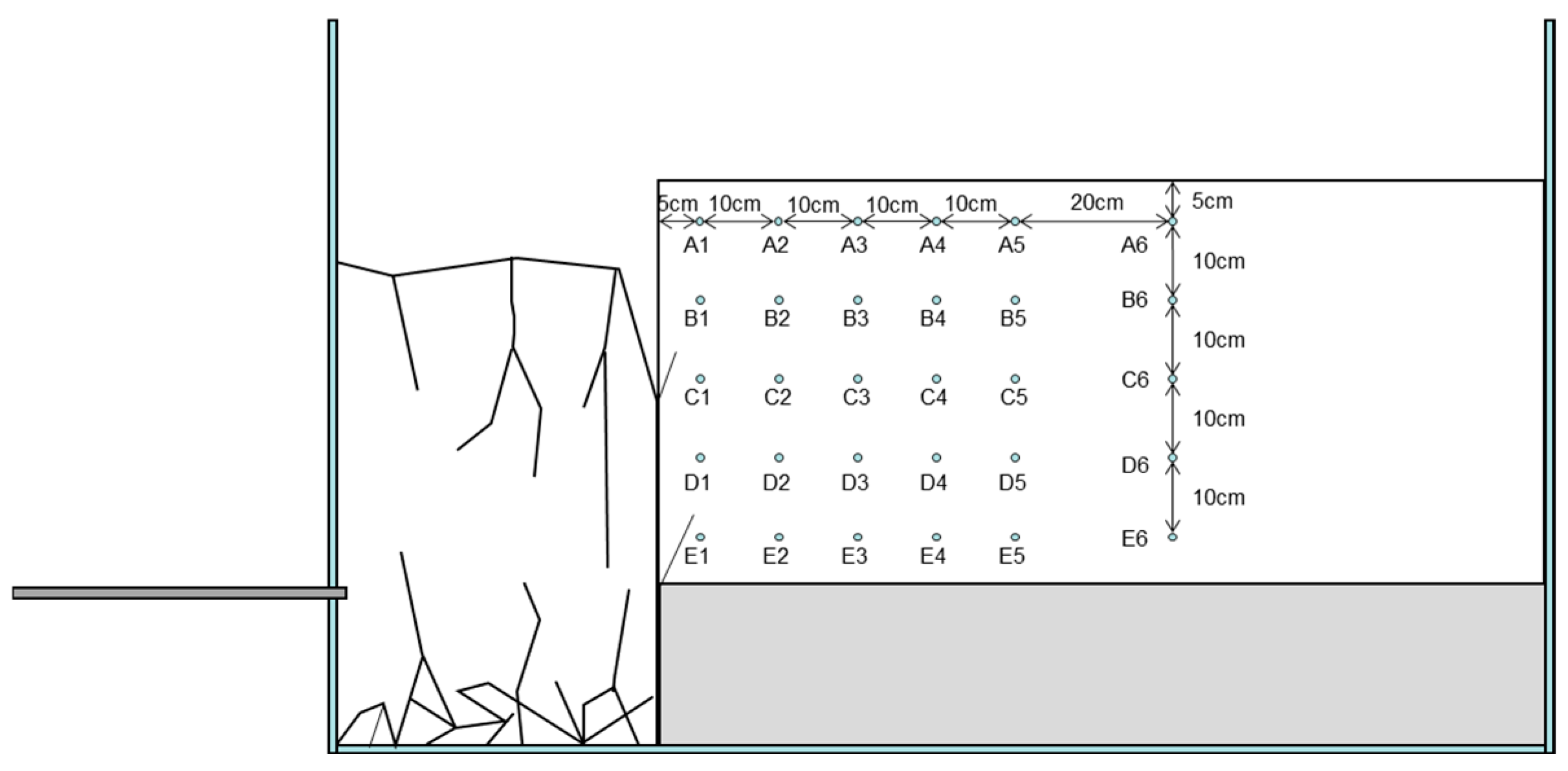

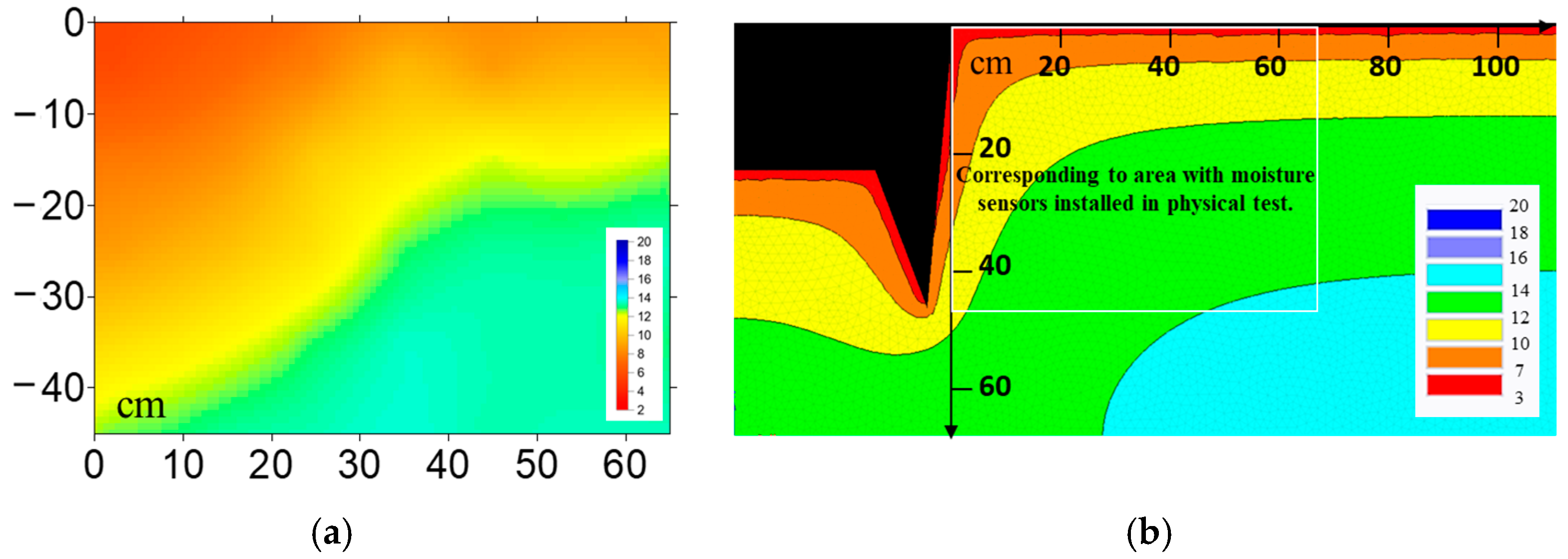

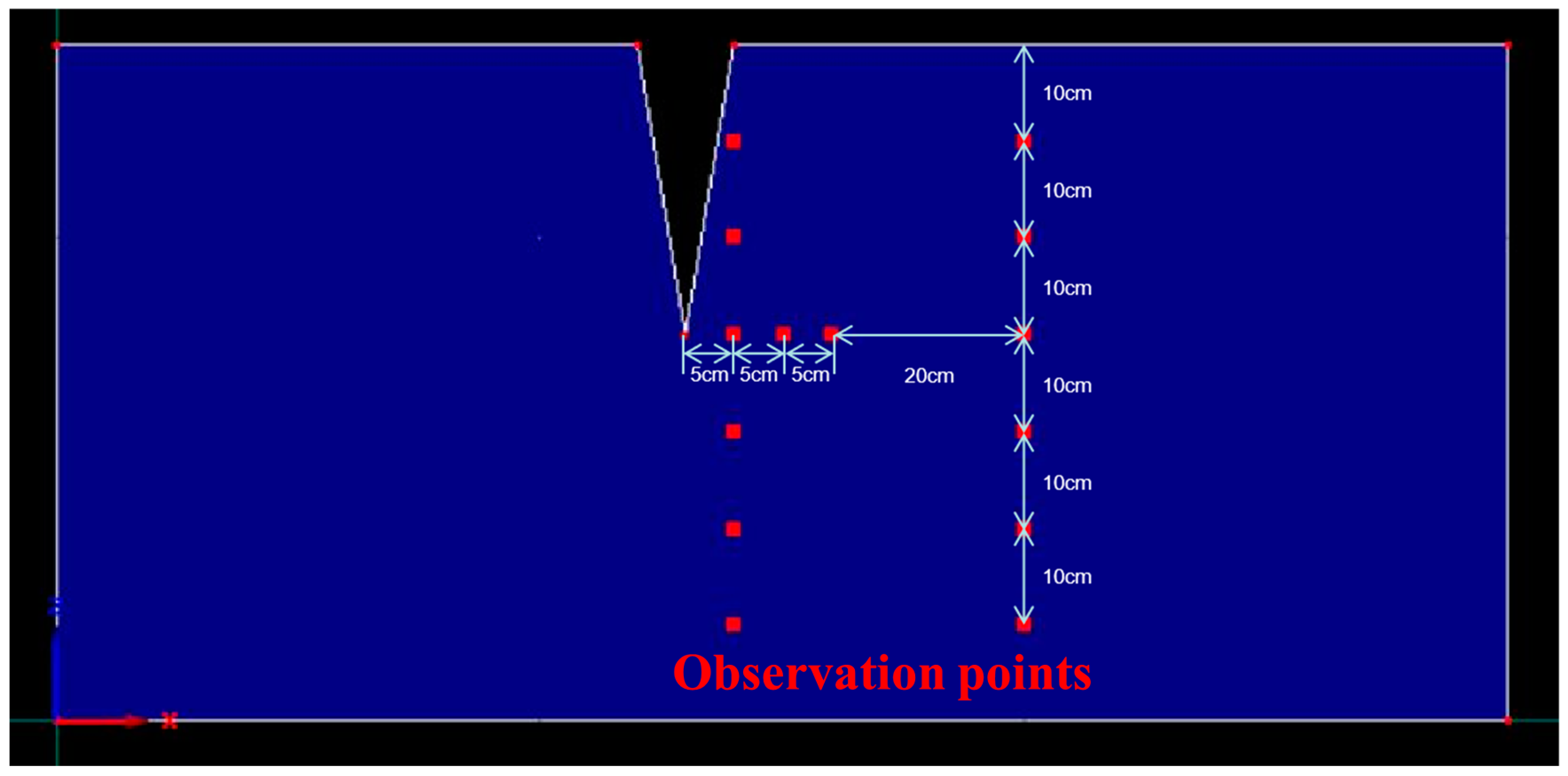


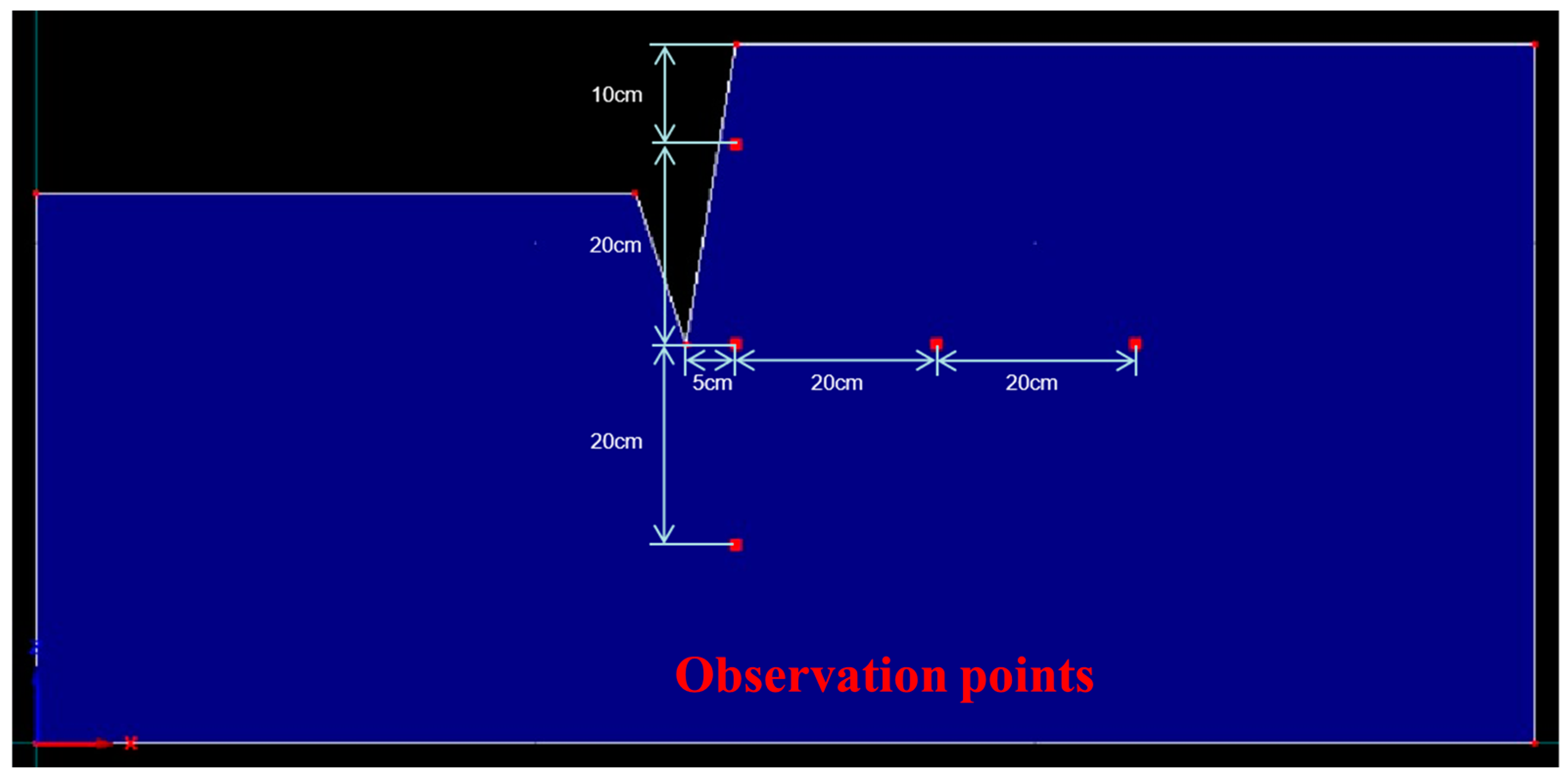
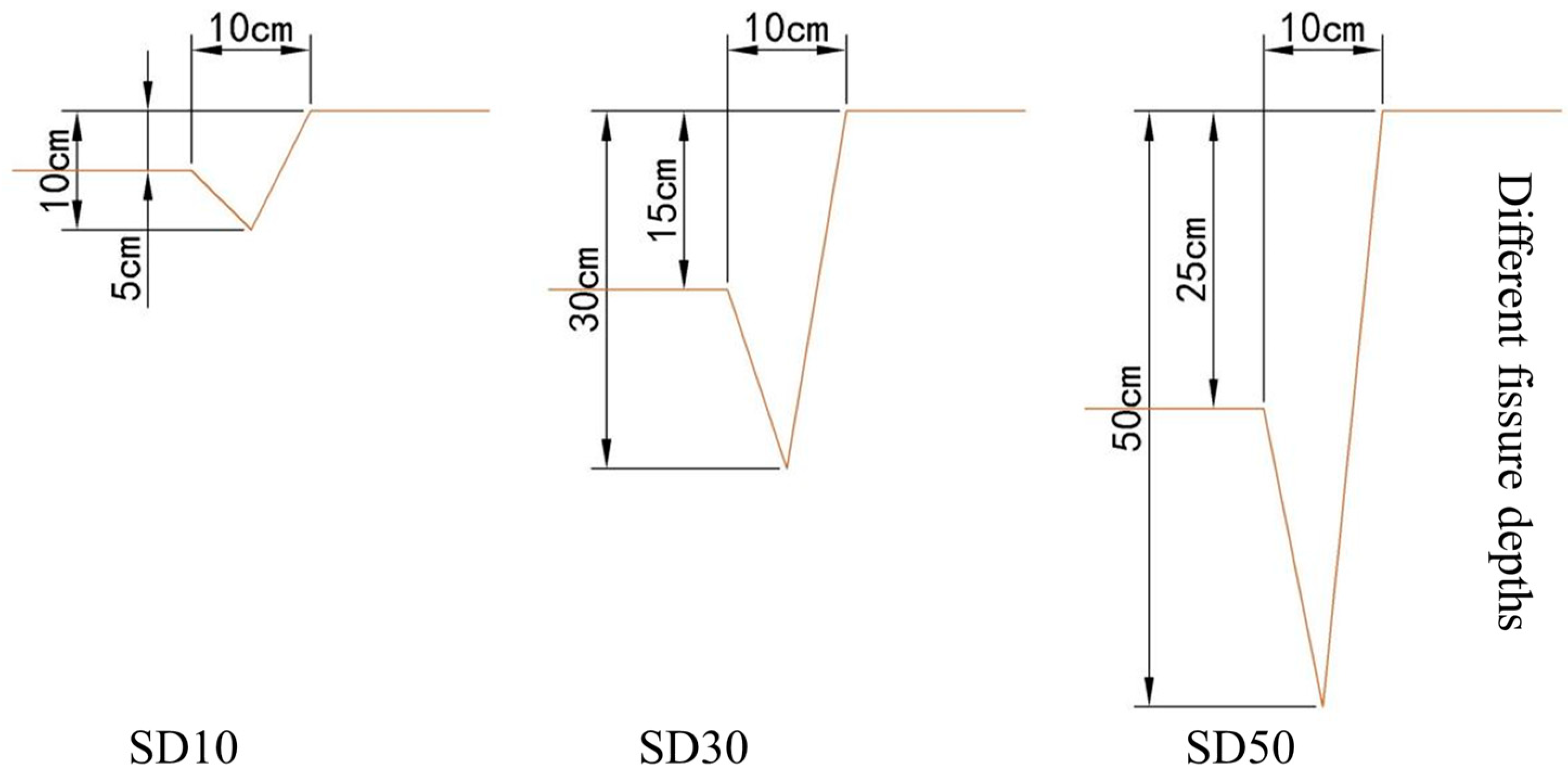


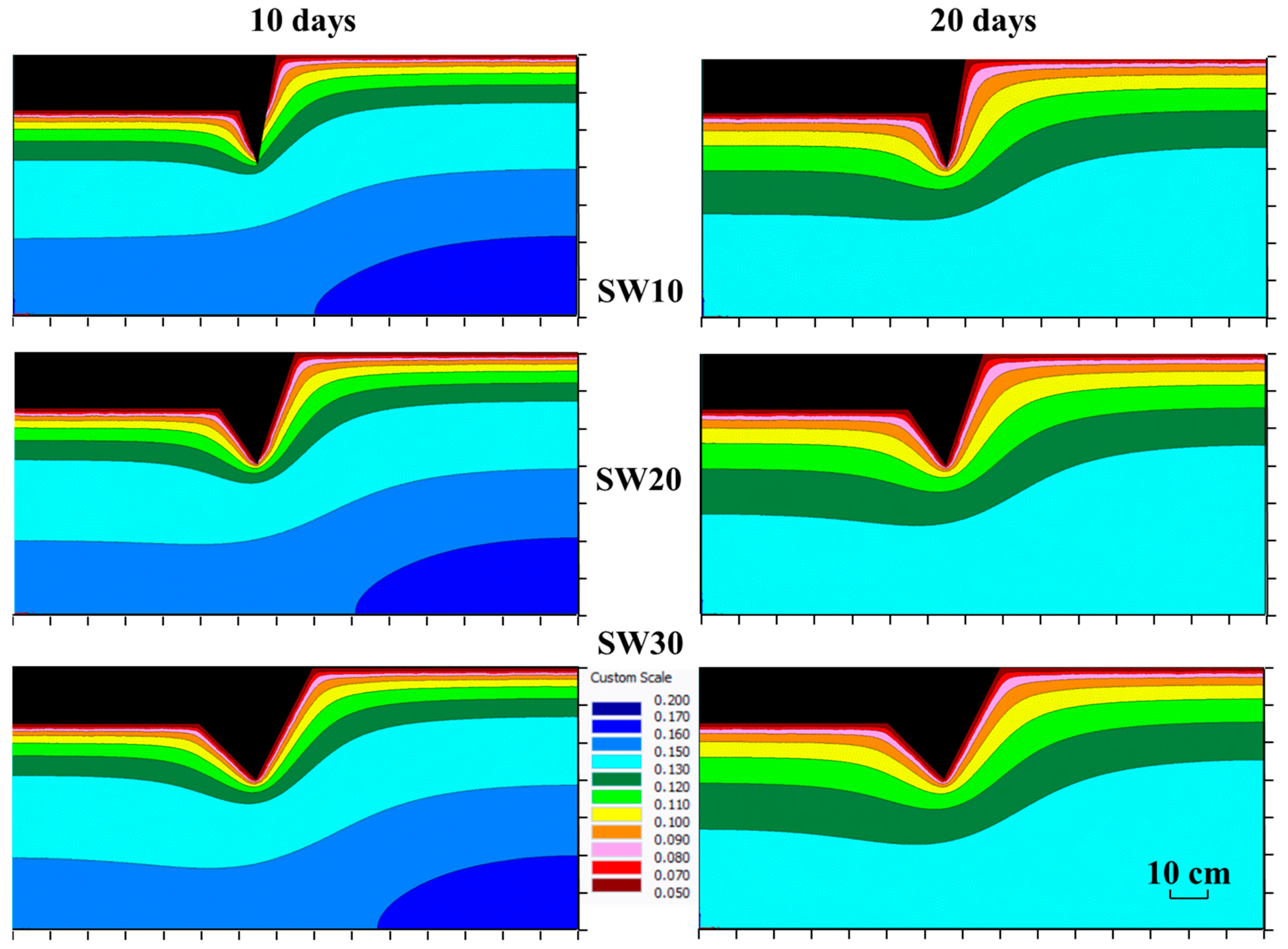
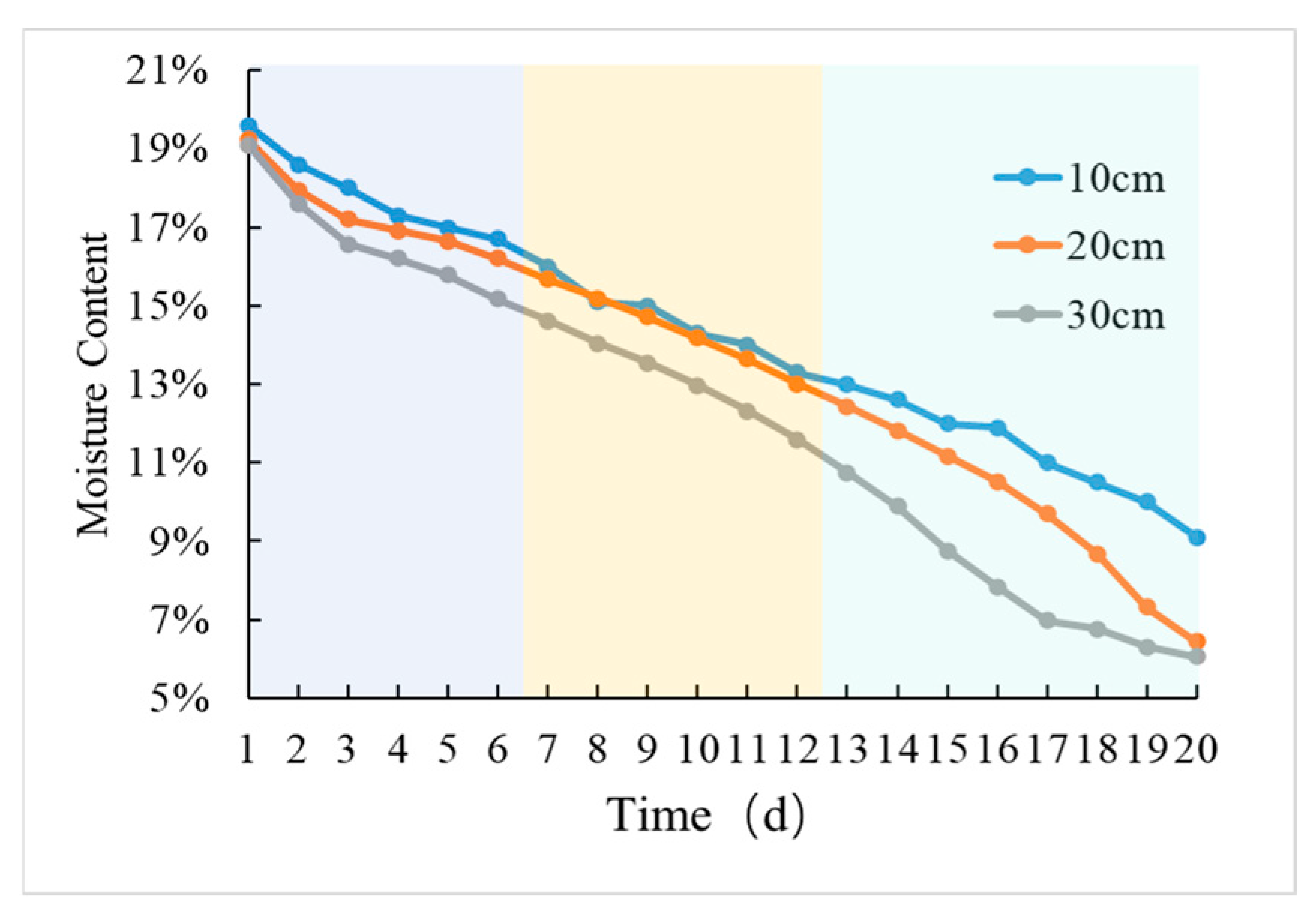
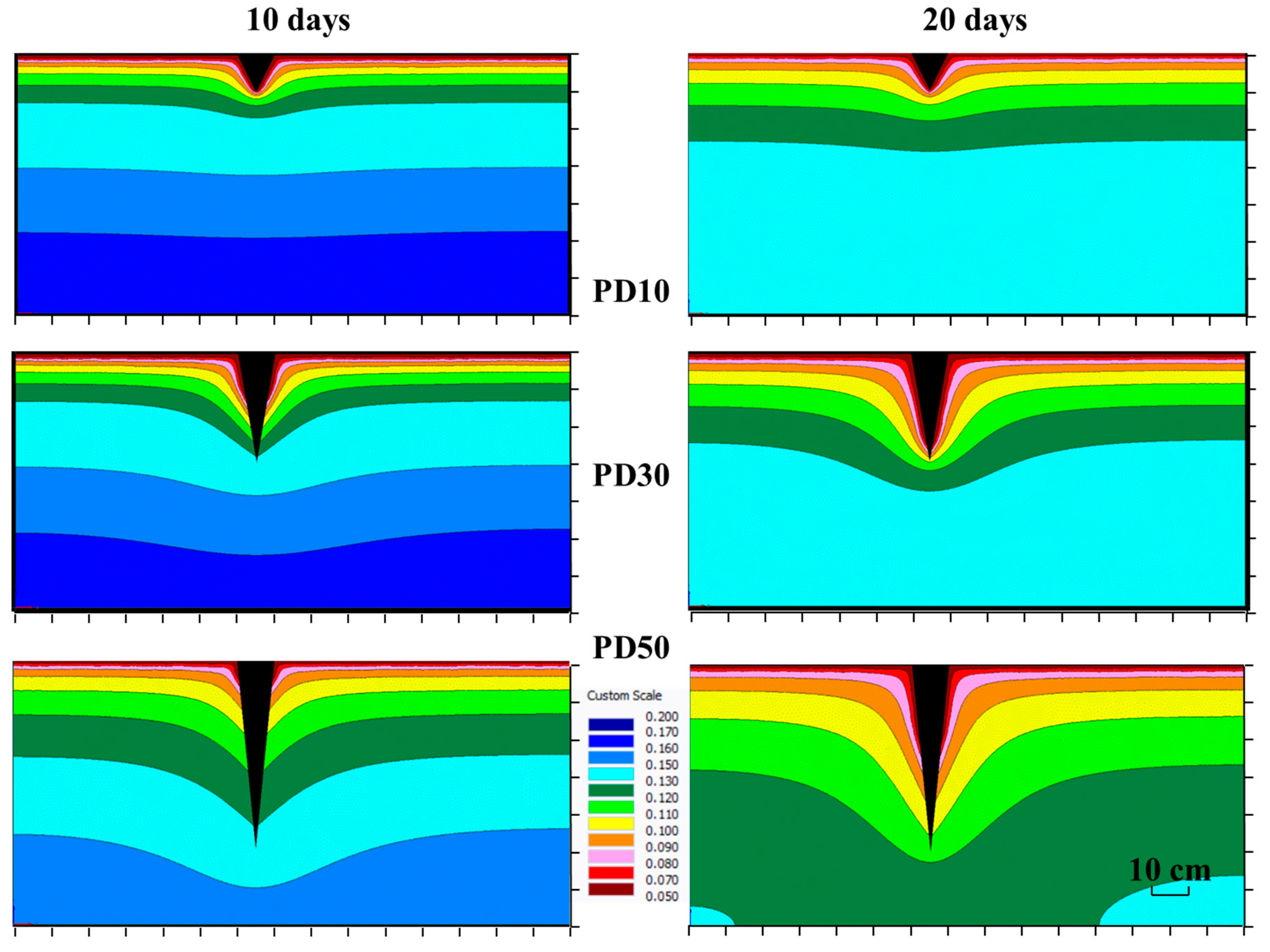




| Qr (−) | Qs (−) | Alpha (1/cm) | n (−) | Ks (cm/day) |
|---|---|---|---|---|
| 0.0497 | 0.3935 | 0.0342 | 1.751 | 104.87 |
| Time (d) | Evaporation Intensity (cm/d) | Time (d) | Evaporation Intensity (cm/d) |
|---|---|---|---|
| 1 | 0.68 | 11 | 0.58 |
| 2 | 0.43 | 12 | 0.4 |
| 3 | 0.74 | 13 | 0.65 |
| 4 | 0.84 | 14 | 0.54 |
| 5 | 0.62 | 15 | 0.5 |
| 6 | 0.57 | 16 | 0.47 |
| 7 | 0.65 | 17 | 0.6 |
| 8 | 0.47 | 18 | 0.63 |
| 9 | 0.55 | 19 | 0.77 |
| 10 | 0.51 | 20 | 0.71 |
| Point | RMSE | RE | Point | RMSE | RE |
|---|---|---|---|---|---|
| A1 | 2.04 | 9.34% | A6 | 0.84 | 2.03% |
| B1 | 2.49 | 19.91% | B6 | 1.13 | 6.29% |
| C1 | 2.23 | 16.08% | C6 | 1.66 | 9.11% |
| D1 | 2.65 | 18.15% | D6 | 2.48 | 15.66% |
| E1 | 1.19 | 5.93% | E6 | 2.10 | 12.56% |
| Mean | 2.12 | 13.88% | 1.64 | 9.13% |
Disclaimer/Publisher’s Note: The statements, opinions and data contained in all publications are solely those of the individual author(s) and contributor(s) and not of MDPI and/or the editor(s). MDPI and/or the editor(s) disclaim responsibility for any injury to people or property resulting from any ideas, methods, instructions or products referred to in the content. |
© 2024 by the authors. Licensee MDPI, Basel, Switzerland. This article is an open access article distributed under the terms and conditions of the Creative Commons Attribution (CC BY) license (https://creativecommons.org/licenses/by/4.0/).
Share and Cite
Song, Z.; Zhang, J.; Chi, M.; Guo, N.; Yang, S.; Guo, Y.; He, R.; Gao, Z. The Influence of the Morphological Characteristics of Mining-Induced Ground Fissures on the Spatiotemporal Distribution of Soil Moisture. Water 2024, 16, 2496. https://doi.org/10.3390/w16172496
Song Z, Zhang J, Chi M, Guo N, Yang S, Guo Y, He R, Gao Z. The Influence of the Morphological Characteristics of Mining-Induced Ground Fissures on the Spatiotemporal Distribution of Soil Moisture. Water. 2024; 16(17):2496. https://doi.org/10.3390/w16172496
Chicago/Turabian StyleSong, Ziheng, Jian Zhang, Mingbo Chi, Nan Guo, Shang Yang, Yangnan Guo, Ruimin He, and Ze Gao. 2024. "The Influence of the Morphological Characteristics of Mining-Induced Ground Fissures on the Spatiotemporal Distribution of Soil Moisture" Water 16, no. 17: 2496. https://doi.org/10.3390/w16172496




